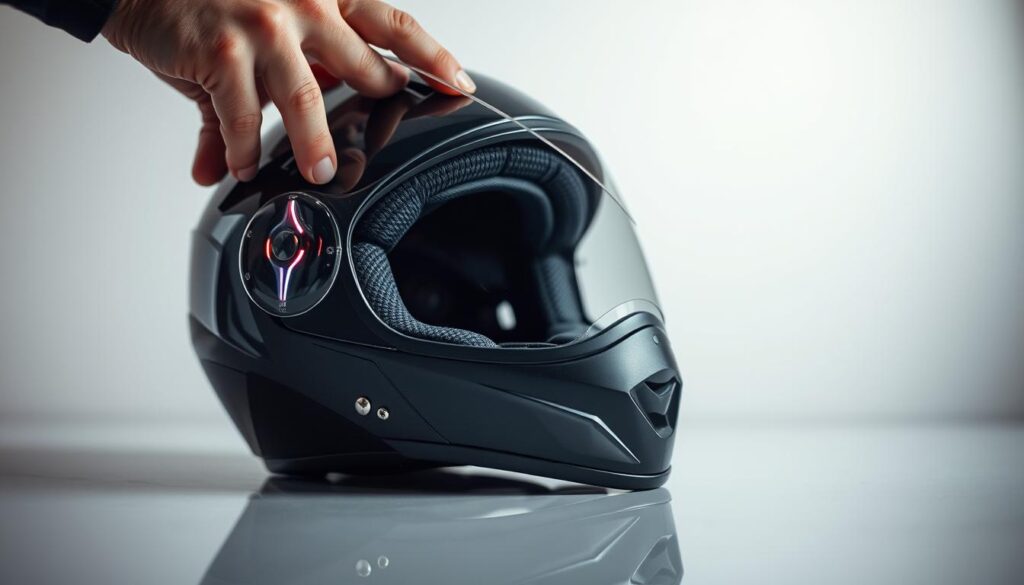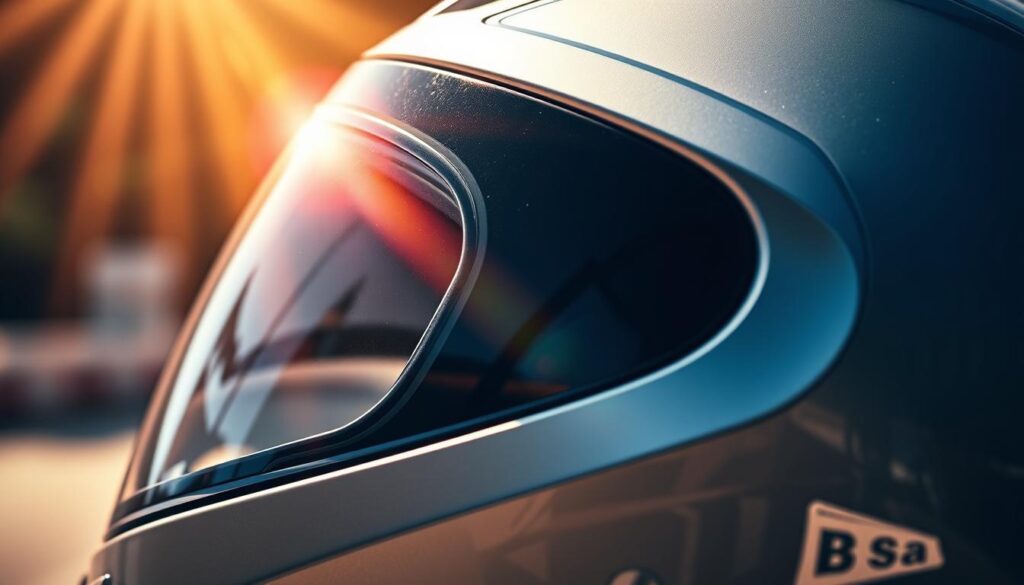Your motorcycle helmet is your key safety gear while riding. Keeping it in good shape is vital not just for looks but for the best protection. This guide explains why helmet care is important and gives you tips on cleaning, checking for damage, and proper storage.
Taking care of your visor improves your ride and keeps you safe. By using this guide, you’ll stay safe and enjoy your motorcycle rides more.
Understanding the Importance of Helmet Care
Keeping your motorcycle helmet in good shape is key to safe riding. Taking care of your helmet makes it last longer and work better. Over time, dirt, sweat, and the environment can damage your helmet’s material. If you don’t take care of it, you could be less safe on your bike.
Looking after your helmet means it won’t need replacing as soon. It stays comfortable and doesn’t get smelly, thanks to less bacteria. By regularly maintaining your helmet, you make sure you’re safer on the road, focusing on what’s ahead.
Caring for your helmet is crucial for your safety. Putting in the effort to maintain it boosts your protection and improves your rides.
Cleaning Your Helmet: Step-by-Step Guide
It’s important to keep your helmet clean for safety and comfort. You can do this by using mild soap, warm water, microfiber cloths, and a soft toothbrush. Stay away from strong chemicals or rough materials because they could harm your helmet.
To start cleaning, first rinse the helmet’s outer part with warm water. This gets rid of dirt on the surface. Then, mix a bit of mild soap with warm water. Use a microfiber cloth to apply this mixture to the helmet. For tough spots, use a soft toothbrush.
Once you’re done scrubbing, rinse the helmet well to remove soap. This stops any damage over time caused by leftovers. After that, use a clean, dry microfiber cloth to dry the helmet. Make sure it’s fully dry before using it again to avoid bad smells or damage.
Inspecting Your Helmet for Damage
Checking your motorcycle helmet often is key to staying safe. Start by looking at the outer shell for cracks, dents, or chips. These flaws can greatly weaken the helmet, making you unsafe on the road.
Then, examine the inner linings for wear. Padding can get thinner or wear out, making it less protective against hits. It’s crucial to check these parts carefully, as worn-out liners won’t guard you well in a crash.
Be sure to look at loose parts too. Cheek pads, internal padding, and buckles should be tight. Any looseness can change how the helmet fits, and that’s important for your comfort and safety.
Finally, helmets must be replaced right after they take a hit. This is true even if you can’t see any damage. Doing this ensures your helmet keeps offering the best defense on the road.

Storing Your Helmet Properly
Storing your helmet the right way is key to making it last. Keep it in a place that’s cool and dry. Don’t let it sit in direct sunlight because this can make the colors fade and weaken the materials.
Rather than leaving your helmet on bike mirrors or handlebars, use a helmet bag or shelf. This helps avoid accidental damage. Hanging your helmet by the chin strap is not a good idea. It can stretch the strap and make it less safe.
Keeping these storage tips in mind will help keep your helmet in top shape. This means you can enjoy your rides for many years to come.
The Lifespan of a Motorcycle Helmet
It’s important for riders to know how long helmets last. Most makers say to get a new helmet every 3 to 5 years. But that’s just a rough guide. How long your helmet really lasts depends on how much you use it, where you ride, and if you take good care of it.
If you ride a lot or in bad weather, your helmet might not last as long. If you see any cracks, dents, or the inside isn’t as comfy, it’s time for a new one. Feeling uncomfortable while wearing your helmet also means you should think about getting another.
Checking your helmet often is a good habit. It helps you spot problems early. Always keep an eye on your helmet’s condition to stay safe on the road. Here’s a simple list of things that affect how long a helmet can last:
| Factor | Impact on Lifespan |
|---|---|
| Frequency of Use | Higher usage leads to quicker wear and tear. |
| Riding Conditions | Extreme weather can degrade materials faster. |
| Maintenance Quality | Proper care can prolong your helmet’s lifespan. |
| Visible Damage | Any signs of damage necessitate immediate replacement. |
| Comfort and Fit | Discomfort may signal that it’s time for a new helmet. |
The Role of Accessories in Helmet Care
Keeping your motorcycle helmet in good shape is more than just washing it. Visor care is crucial because it helps you see clearly while riding. It’s best to clean your visor with a soft solution. This keeps it clear without causing scratches. You should use soft microfiber cloths for cleaning.
Removable liners are important too. They make it easy to keep your helmet clean. After long rides, they can be washed to remove sweat and smell. This makes your rides more enjoyable.
Don’t forget about anti-fog treatments for your visor. They help keep your vision clear in different weather. Also, regularly check your visor’s parts to make sure they work well. Taking care of your helmet like this is good for both its condition and your safety on the road.
| Helmet Accessory | Care Instructions | Benefits |
|---|---|---|
| Visor | Clean with gentle solution and microfiber cloth | Improves visibility |
| Removable Liner | Wash regularly to maintain hygiene | Enhances comfort and odor control |
| Anti-Fog Treatment | Apply regularly for optimal performance | Prevents fogging for clearer vision |
| Visor Mechanism | Check for functionality | Ensures smooth operation |
Dealing with Odors and Sweat
Your helmet keeps you safe and comfortable on rides. But it can get smelly from sweat. Clean the liners and cheek pads often. This will get rid of bad smells and make your helmet fresh every time you wear it.
Wipe the inside of your helmet after riding. This stops moisture and bad smells from building up. Use products made for helmets, like anti-bacterial sprays and powders. They fight the bacteria that cause the bad odors.
Keeping your helmet clean means more enjoyable rides. A helmet that smells good makes riding more comfortable. This is important for every rider.
Helmet Care for Different Weather Conditions
Understanding how weather affects helmets is key to keeping them safe and long-lasting. Rain can soak the helmet’s lining, leading to bad smells and wear if it’s not dried well. After riding in the rain, use a soft cloth for the outside and let the inside air dry completely.
Too much heat is another problem for motorcycle helmets. It can break down the materials, making the helmet less durable. If you live in a hot place, make sure your helmet is well-ventilated. Also, clean it often to prevent sweat from harming the materials and causing bad odors.
Cold weather brings its own challenges, like frost and ice that can make it hard to see. Using a visor with anti-fog treatment helps keep it clear when it gets cold. Always inspect your helmet for any damage after it’s been in extreme temperatures.
Riding in various weather conditions requires paying extra attention to your helmet. Regular checks and care will help you take better care of it. This way, your helmet stays protective, no matter the weather.
The Impact of Sun and UV Exposure
UV rays can really damage motorcycle helmets over time. This damage can make helmets look old and weaken their structure. It’s important to regularly check your helmet for any wear. This includes looking at straps and padding which can be weakened by the sun.
Using products that protect your helmet from UV rays is a smart move. These products help prevent sun damage. When you’re not using your helmet, keep it in a shaded spot. Or, use bags that resist UV rays to keep it safe and looking new.
By taking these steps, you make sure your helmet stays in great shape. This means you’re safe and stylish while you ride.

| Effect of Sun Damage | Impact on Helmet | Preventive Measures |
|---|---|---|
| Fading | Affects appearance and confidence | Use UV protection sprays |
| Material Degradation | Weakens protection capability | Store in cool, shaded areas |
| Strap Weakening | Increases risk during use | Use UV-resistant helmet bags |
| Padded Interior Damage | Reduces comfort and fit | Regular inspections and care |
Myths About Motorcycle Helmet Care
Many myths about helmet care can confuse riders. For example, some think helmets expire after a few years. But, the truth is their life span is based more on use and care rather than time. Checking for damage often is more important than following set expiration dates.
Some believe machine washing helmets is safe. This isn’t true because it can harm the foam inside and the shell outside. It’s better to gently wash helmets by hand with soap and water. Understanding these myths helps riders focus on what’s important for safety.
It’s crucial to know that visible damage, like cracks, reduces a helmet’s safety. Checking helmets often ensures problems are fixed right away. By debunking myths, you keep your protection strong and enjoy your rides more.
Getting Professional Help: When to Consult an Expert
There are times when you might need more help than you can give yourself. If your helmet is badly damaged or was part of an accident, get it checked by a pro. A helmet expert can look it over and tell if it’s still safe to wear. Keeping your helmet in top shape is key to staying safe while riding.
A pro can also help you put in new parts the right way, so everything works like it should. Sometimes, you can’t see all the damage to your helmet’s inside; only an expert can say if it’s okay to keep using it.
Plus, professionals offer special cleaning services that can make your helmet last longer. They use special methods and cleaners that are better than what you may have at home. Knowing when to get help from a helmet expert can make sure you stay safe and confident on the road.




